Rank Species | Higher classification Megaloceros | |
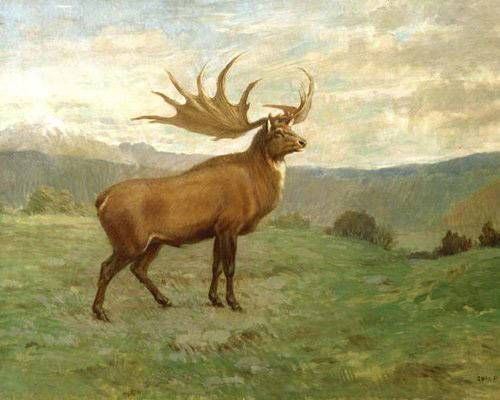 | ||
Similar deer, Megaloceros, Woolly rhinoceros, Mammal, Cave bear | ||
Channel 4 extinct the irish elk
The irish elk (Megaloceros giganteus) also called the giant deer or Irish giant deer, is an extinct species of deer in the genus Megaloceros and is one of the largest deer that ever lived. Its range extended across Eurasia during the Pleistocene, from Ireland to Siberia to China. A related form is recorded in China during the Late Pleistocene. The most recent remains of the species have been carbon dated to about 7,700 years ago in Siberia. Although most skeletons have been found in bogs in Ireland, the animal was not exclusive to Ireland and was not closely related to either of the living species currently called Elk - Alces alces (the European elk, known in North America as the moose) or Cervus canadensis (the North American elk or wapiti). For this reason, the name "Giant deer" is used in some publications, instead of "Irish elk". A study has suggested that the Irish elk was closely related to the red deer (Cervus elaphus). However, other phylogenetic analyses support the idea of a sister-group relationship between fallow deer (Dama dama) and the Irish elk.
Contents
- Channel 4 extinct the irish elk
- I is for irish elk
- Taxonomy
- Evolution
- Description
- Size of antlers
- Orthogenesis
- Reproduction
- Extinction
- Folklore
- Northern Ireland
- Potential revival
- References

I is for irish elk
Taxonomy

In the seventeenth and eighteenth centuries it began to be apparent to scientists that many fossilized specimens being discovered did not represent any organisms that were currently living on earth. The Irish elk was among these specimens. Neither exclusive to Ireland nor an elk, it was named so because the most well-known and most preserved fossil specimens have been found in lake sediments and peat bogs in Ireland. The Irish elk had a far-reaching range, being located throughout Europe, northern Africa, and some related forms located in China. The first scientists’ descriptions of the elk erroneously confused the animal with the American moose, while other scientists believed the elk was identical to the European reindeer. These scientists did not have the current conception of evolutionary biology that we have now. They did not consider extinction, believing instead that the unexplained fossils had living descendants in undiscovered parts of the globe. French scientist Georges Cuvier was the first to challenge that notion, documenting that the Irish elk did not belong to any species of mammal that was living at the time. His study of the Irish elk was a key moment in the history of the study of extinction.
Evolution
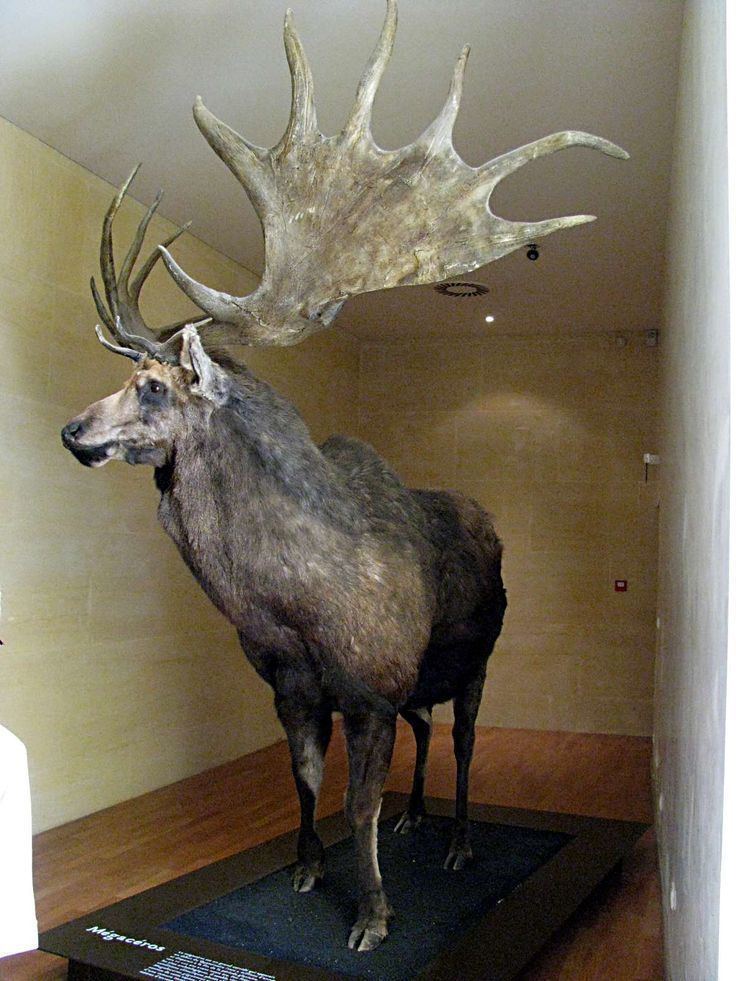
The Irish elk evolved throughout the last few million years during the Glacial Periods and Ice Age, specifically the Pleistocene Epoch. Once established, the elk spread throughout Europe, northern Asia and Africa, and some parts of China. Physically, the Irish elk was the heaviest known member of the “Old World deer”, a division of the subfamily Cervinae whose groups the “Old World deer” and “New World deer” are distinguished by foot structure rather than geographical origin. Most remains of Irish elk date from between 11,750 BP (Before Present)-with the first Megaloceros giganteus appearing about 400,000 years ago-and 10,950 BP. Studies have shown they possibly evolved from M. antecedens. The earlier taxon — sometimes considered a paleosubspecies M. giganteus antecedens — is similar but had more complex and compact antlers.
Description
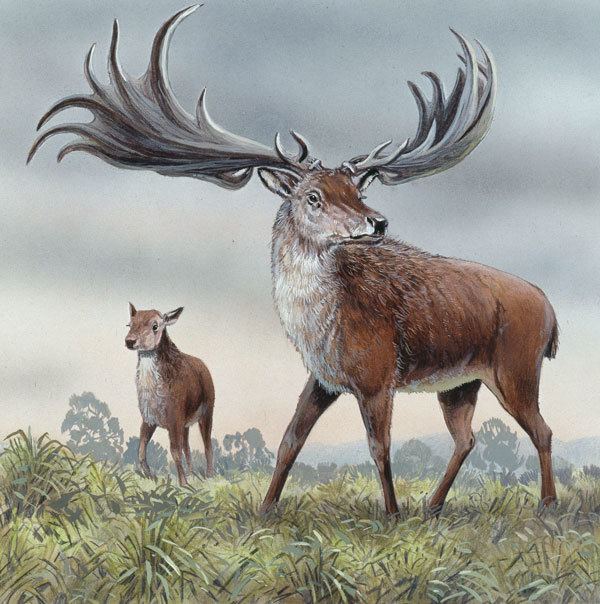
The Irish elk stood about 2.1 metres (6.9 ft) tall at the shoulders carrying the largest antlers of any known cervid (a maximum of 3.65 m (12.0 ft) from tip to tip and weighing up to 40 kg (88 lb)). In body size, the Irish Elk tied with the extant moose subspecies of Alaska (Alces alces gigas) as the third largest known deer, second and first belonging to the Cervalces genus (C. scotti and C.latifrons respectively). The Irish elk is estimated to have attained a total mass of 540–600 kg (1,190–1,323 lb), with large specimens having weighed 700 kg (1,543 lb) or more, roughly similar to the Alaskan Moose. A significant collection of M. giganteus skeletons can be found at the Natural History Museum in Dublin.
Size of antlers
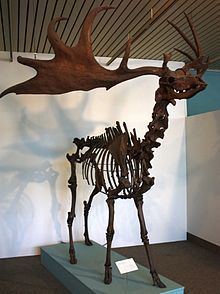
The size of Irish elk antlers are distinctive. Scientists have proposed multiple theories regarding the evolution of these antlers. One theory is that their antlers, under constant and strong sexual selection, increased in size because males were using them in combat for access to females. Thus, it is hypothesized that they eventually became so unwieldy that the Irish Elk could not carry on the normal business of life and so became extinct. It was not until Stephen Jay Gould'S important 1974 essay on Megaloceros that this theory was tested rigorously.
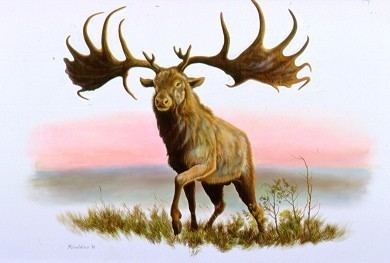
Gould demonstrated that for deer in general, species with a larger body size have antlers that are more than proportionately larger, a consequence of allometry, or differential growth rate of body size and antler size during development. Irish Elk had antlers of the appropriate size in correlation to their massive bodies. This does not mean that sexual selection played no part in maintaining large antler size, only that the antlers of the species' ancestors were already large to begin with. Indeed, Gould concluded that the large antler size and their position on the skull was very much maintained by sexual selection: they were morphologically ill-suited for combat between males, but their position was ideal to present them to intimidate rivals or impress females. Unlike other deer, M. giganteus did not even have to turn its head to present the antlers to best effect, but could accomplish this by simply looking straight ahead. The size of antlers has also been attributed to the health of the Irish elk. "If the Irish elk responded to nutritional restriction as red deer do, a huge and well-fed stag with 40 kg antlers (the near maximal size) would have had 20 to 28 kg antlers under poor conditions. These estimates are within the range of extant moose Alces alces antlers. More typical prime stags with 35 kg antlers would have had 18 to 25 kg antlers in times of nutritional stress." "A linear measure of antler size (basal circumference), however, was reduced even further to 41% of the mainland mean. Because basal circumference is highly correlated with other linear measures of antler size, such a decrease indicates that insular antler mass dropped to 1/14th of the mainland antler mass. This reduction in antler mass is 2.7 times more extreme than expected given the allometric relationship between antler and body masses in red deer and demonstrates a rapid evolution of smaller antlers. A similar change in a typical Irish elk population with prime stags having 35 kg antlers would result in antler weights of 13 kg or less in worsening climatic conditions. This estimate is within the range of extant wapiti/red deer (Cervus spp.) antler weights.
It has been noted that Irish elk stags in more adverse environments had smaller bodies and relatively even smaller antlers, but proponents of the antler-extinction hypothesis have not addressed the possibility of rapid evolutionary reduction in antler size. We expect that the antlers of the Irish elk should have been able to evolve rapidly in the face of selection for smaller and less expensive sizes. This conclusion is supported by the great diversity of Irish elk antler forms found among different populations at different times, including compact upright orientations possibly from populations inhabiting more heavily wooded environments suggesting the evolutionary malleability of Irish elk antlers." In 1987, Kitchener presented evidence that Irish elk antlers were in fact used for fighting. In addition, the Irish elk's antlers had several functions such as being a display for attraction of females and dominance of rival males. The elks shed their antlers and re-grew a new pair during mating season. Ultimately, the decrease in energy intake by the Late Pleistocene, influenced the ability to produce for Irish elk females.
Orthogenesis
Before the 20th century, the Irish elk was a prime example of orthogenesis. Orthogenesis, also known as straight line evolution, is an evolutionary mechanism in which the successive organisms within the lineage of an evolutionary series become increasingly modified in a single undeviating direction. Orthogenesis was a widely accepted evolutionary mechanism in the 19th and 20th centuries. Orthogenesis is only a hypothesis, unlike natural selection which is understood by the scientific community as a theory. It was popular amongst anti-Darwinian paleontologists because it stated that evolution proceeded void of natural selection in a straight line. In terms of the Irish elk, it is believed that orthogenesis caused an evolutionary trajectory towards antlers which became larger and larger. This was due to sexual selection which drove an increase in antler size. These antlers caused eventual extinction because the Irish elk’s antlers would grow to sizes which inhibited proper feeding habits and caused the animal to become trapped in tree branches.
Other examples of orthogenesis include saber tooth tigers’ teeth growing to unbearable sizes or oysters coiling their valves into itself until it suffocated. The Irish elk was a prime example of orthogenesis because it had evolved from a smaller ancestor with smaller antlers. However, in the 1930s, orthogenesis was disproved by Darwinians led by Julian Huxley, who noted that antler size was relative to body size. Because the Irish elk was a large organism compared to its smaller relatives such as deer, there was an allometric relationship between the antlers and body size. This theory, too, was countered by Stephen Jay Gould, as he deemed the allometry theory to be very similar to the orthogenesis theory. Gould was convinced that the elk's antler served a primary, unknown purpose. He believed that their immense antlers did not only evolve for combat but that they were also visual representations. Gould and many modern-day scientists have concluded that the antlers served as signals, in which the male elk with large antlers were more suited to attract females. Thus, there is an increasing amount of evidence pointing to the idea that sexual selection was the driving force behind the large antlers, rather than orthogenesis or natural selection.
It is easy to advance a number of hypotheses regarding the disappearance of the more localized populations of this species. The situation is less clear regarding the final demise of the Irish elk in continental Eurasia east of the Urals. Stuart et al. (2004) tentatively suggest that a combination of human presence along rivers and slow decrease in habitat quality in upland areas presented the last Irish elk with the choice of either good habitat but considerable hunting pressure, or general absence of humans in a suboptimal habitat.
Reproduction
There are frequent debates as to whether or not sexual selection led to the Irish elk's extinction. Sexual selection can increase or decrease a population's chance of extinction, due to behaviors such as male-male competition and female choice. Also, sexual harassment by males can result in lower female fecundity or even death. Regardless of the details of the species' life history, extinction would require that too few males survive to maturity to fertilize a sufficient number of females to maintain a viable population. When it comes to male-male competition, if the assumption is that detrimental effects are clear in only the males, a surviving male would have a large amount of females to choose from, with little competition. Selection must, therefore, favor the less extreme male genotypes, and it appears impossible to generate a scenario where males with larger antlers are still selected for when the lifetime reproductive success of males with large antlers approaches zero (as required for deterministic extinction to occur).
In female choice, sexual selection could, thus, reinforce natural selection and lead to quicker responses to environmental changes, should they occur. With a decrease in male population, females have fewer choices, which could result in inbreeding. This can pose significant threats to population survival. However, much of these studies are contradicting. Females may adaptively avoid the accumulation of inbreeding, so that female choice might increase effective population size.
Fossils of the late Pleistocene elk Megaloceros giganteus from Ballybetagh bog, near Dublin, Ireland, indicate that males segregated from females during winters. This type of segregation implies that the Irish elk had behaviors such as rutting and polygynous mating systems, where a single male mates with two or more females. This also supports the belief that the large antler size was used for social display. Within male groups, winterkill was the chief cause of death and was highest among juveniles and small adults with small antlers.
Extinction
Traditionally, discussion of the cause of their extinction has focused on the antler size (rather than on their overall body size), which may be due more to their impact on the observer than any actual property. Some have suggested hunting by humans was a contributing factor in the demise of the Irish elk, as may have been the case with other prehistoric megafauna, even assuming that the large antler size restricted the movement of males through forested regions or that it was by some other means a "maladaptation". Others assume the ultimate cause of extinction may have been the adaptations for mineral metabolism that were beneficial to the Irish elk until vegetation changed. But given the difficulty of recovering quantitative records of human hunting impacts from the sub-fossil record alone, the role of humans in the extinction of the Irish elk is not yet clear.
Some research has suggested that a lack of sufficient high-quality forage caused the extinction of the elk. According to an article written by researchers Silvia Gonzalez, Andrew Kitcheneri, and Adrian Lister, in 2000, a reduction in forest density into the Late Pleistocene decreased nutritional selection and is believed to have led to a conflict between sexual selection and ultimately a decrease in antler and body size, which can explain what may have caused their demise. High amounts of calcium and phosphate compounds are required to form antlers, and therefore large quantities of these minerals are required for the massive structures of the Irish elk. The males (and male deer in general) met this requirement partly from their bones, replenishing them from food plants after the antlers were grown or reclaiming the nutrients from discarded antlers (as has been observed in extant deer). Thus, in the antler growth phase, giant deer suffered from a condition similar to osteoporosis. When the climate changed at the end of the last glacial period, the vegetation in the animal's habitat also changed towards species that presumably could not deliver sufficient amounts of the required minerals, at least in the western part of its range.
Simply blaming antler size for their extinction may not be entirely accurate. The most likely cause is the significantly shortened growing season seen toward the end of the Pleistocene Era. This reduced availability in nutrition resulted in the lowering of the female reproduction output by about 50%.
However, the most recent specimen of M. giganteus in northern Siberia, dated to approximately 7,700 years ago - well after the end of the last glacial period - shows no sign of nutrient stress. They come from a region with a continental climate where the proposed vegetation changes had not (yet) occurred.
New radiocarbon dates from specimens in stratified contexts suggest that giant deer still existed 1,400 years after their supposed extinction. Giant deer fossils found on the Isle of Man at Ballaugh confirm the survival of the species into early Holocene in at least this area. The Ballaugh Elk skeleton is smaller than the entire range of Irish skeletons, but has a relatively large skull and the antlers are well-sized for an adult male. This suggests that size decreased into the Holocene.
There is strong intraspecific allometry among Irish deer. Smaller animals have relatively shorter antlers. Reduced display organs are theorized to indicate a prelude to extinction from nutritional stress. Reduced forage density leads to a conflict between sexual selection for antler size and nutritional selection pressures. These factors reduced populations and the body size of the giant deer. However, data indicates that they are unlikely to have been wholly responsible for the animal's extinction. With available evidence, it is hard to define the cause of extinction.
Many scientists argue that factors like ecological change, virulent disease, and hunting by people wiped out many large mammal species during the end of the European Ice age, including the giant deer. Fossils found on the Isle of Man at Ballaugh, and at two places in western Siberia postdating the supposed extinction of the species show that, whatever the causes, the actual termination of the species was likely due to a variety of factors which had different significance and timing in different parts of the species' range.
Folklore
A folk memory of the Irish Elk was once thought to be preserved in the Middle High German word Schelch, a large beast mentioned in the 13th-century Nibelungenlied along with the then-extant aurochs (Dar nach schluch er schiere, einen Wisent und einen Elch, Starcher Ure vier, und einen grimmen Schelch / "After this he straightway slew a bison and an Elk, Of the strong Wild Oxen four, and a single fierce Schelch."). The Middle Irish word segh was also suggested as a reference to the Irish Elk. Turf cutters of Clooney and Tulla in County Clare, Ireland referred to the Irish Elk as the Fiaghmore. However, these interpretations are not conclusive.
Northern Ireland
An Irish elk is displayed on the Coat of arms of Northern Ireland.
Potential revival
This species has been selected by the Long Now Foundation as a potential candidate for de-extinction.
